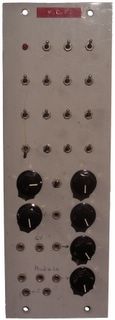...off to Forbin
Well it has taken an eternity... or it does seem like it but today i have started on the new Blog about Forbin which is what ORT MkII was to be... see: Forbin
Well it has taken an eternity... or it does seem like it but today i have started on the new Blog about Forbin which is what ORT MkII was to be... see: Forbin
Not much activity on the ORT at the moment as I am attempting to finish off the Minimoog. As I noted in a previous post the Keyboard for the Minimoog got effectively destroyed when it was filled with rainwater. The actual mechanisim that was used in the Mini was manufactured by a company called Kimber-Allen, who I believe are not in bussiness any more. The actual design is really very complicated. The actual up/down keystroke movement is transfered through a lot of springs and small arms to move a rather wobbly mechanisim with two gold plated springs upon it. These springs in turn provided the key information and the gate information. Rather than spend a LOT of time rebuilding all of this and probably ending up with a sub-optimal design I decided to find a replacement keyboard. A late 70's Italian Organ proved to be prefect. It was very cheap, the key mechanisim was simple and easy to adapt, the keys looked a little yellow and discoloured so that they looked about the same vintage as the rest of the unit. Each key has single contect and all the keys are tied togther with a diode ORing scheme. I obviously couldn't use the existing method of a voltage divider that was used in the old keyboard. I didn't really want to do that anyway as I wanted a MIDI feed out from the keyboard to control other stuff anyway and it didn't really seem sensible to take a digital signal into the analog domain then back again. I then decided to split the whole thing between two microcontrollers. One in the keyboard that just scanned the keys and sent the information serially to another micrcontroller inside the electronics unit of the Minimoog. I used the AVR microcontroller as it is cheap, easily available, powerful and well supported with various software tools.
This is the MIF or Multiple Identity Filter on the ORT. It was the second module that I made for the ORT and it uses a Curtis Electromuse CEM3340 VCF device. The design is by a chap called Craig Anderton who was an electronic music equipment designer who had an article in a magazine called Contemporary Keyboard. This was a big project for the magazine and was spread across 3 editions. You can read the original article at this site (the owner of the site doesn't give his name). I had actually never read the first part until I stumbled upon this pdf on the web! Anyway here is the front panel. It has a very similar layout to the original; which was important for getting the various operating modes right.



Well things are going slowly on the ORT at the moment as I have been distracted by a number of things... One of which is a score by a chap called M.Pointon that was printed in an electronics magazine called Practical Electronics. It is not often that you get a music score in an electronics magazine! This work was in the June and July edition from 1975. It was written to be performed on a synthesizer called the Minisonic, which really is a pretty apalling bit of kit but I suppose at the time was interesting. I have had the article squirreled away for an awfully long time. I bought the magaines, from which it came, sometime in the early eighties. I think from the Save the Children Fund book sale at the University of Western Australia. I have scanned it in and made it into a pdf file which when I find enough space on the net somewhere I will put it so you can all see it. In the meantime I have been having some fun trying to recreate the piece on some software tools that I found on the net. It is quite interesting when you realize some of the problems that exisited trying to record a fairly simple score on equipment in an amateur situation about 30 years ago. If I finsh it I will post an MP3 or OGG of the result for your listening pleasure. It almost certainly isn't going to be easy listening... I can tell that already!!!
This is the Front Panel of the old VCO or Voltage Controlled Oscillator. This module basically converts a voltage into a signal of varying frequency. The relationship between the voltage and the frequency is 1V for every octave over about a 8 octave range. This VCO has a very expensive IC in it which is now kaput so it will not be used again as better designs can be realized more cheaply. I suppose I will recycle the knobs...
